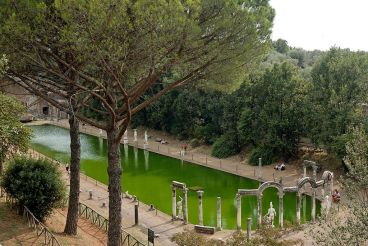Villa d'Este, Tivoli

On the outskirts of a small town of Tivoli one of the most interesting sights of the Italian land – Villa d'Este – is located. In a relatively limited area, there is an interesting palace, a whole collection of fountains, the number of which reaches five hundred, a network of cascades, grottoes and reservoirs. A stunning place will be to the taste of history lovers, and those who prefer a light walk along beautiful alleys among trees and ponds.
History of the villa
The idea of creating the villa belongs to Cardinal Ippolito II d'Este, who since 1550 had been the governor of Tivoli. Previously, the building served as a monastery, so its appearance did not meet the requirements for the governor's residence. However, the desire to found a large park on the slopes of the mountain was waiting for its implementation for 10 years. Only after 1560 the design was completed, the author of which was the architect Pirro Ligorio. Alberto Galvani the court architect was the head of the implementation.
The decoration of the rooms was led by such vivid representatives of Roman Mannerism as Livio Agresti, Federico Zuccari, Girolamo Muziano, Cesare Nebbia, Antonio Tempesta.
Preparations were close to completion when Ippolito died.
Further, the development of the villa was taken over by Cardinal Alessandro d'Este. Since 1605 the works on the reconstruction of the garden, its re-planning, repair of fountains were implemented. In 1660-1670 the construction continues with Giovanni Lorenzo Bernini.
However, Villa d'Este met a decline due to lack of interest. In the 18th century, the estate passed into the ownership of the Habsburgs. At this time, the fountains were destroyed because of prolonged downtime, the garden was overgrown, the collection of statues was lost.
The resumption began only in the second half of the 19th century under the leadership of Cardinal Gustav von Hohenlohe-Schillingsfürst. The villa becomes a cultural center. It is noteworthy that the composer Franz Liszt spent a lot of time here.
During the First World War this place passes into the ownership of the state. Then, as well as after the devastation caused by the Second World War, the villa experienced rather large restoration works.
In 2001, Villa d'Este in Tivoli was listed as a UNESCO World Heritage Site.
What can you see at Villa d'Este
The complex allows visitors to get to know both the grandeur of architectural structures and the beauty of nature, strolling along the paths of the park. Here it is worth paying attention to:
- The Palace d'Este is a fine example of Italian medieval architecture. Ancient frescoes, mosaics, other elements of décor are preserved here.
- The Museum Laboratory of Ancient Books is engaged in the preservation, reconstruction, study of ancient books and documents. There is also an international center for various conferences and other events.
- Fountain of the "Organ" – incredible music can be enjoyed every two hours, starting at 10:30. Sound is produced by the flow of water passing through the organ pipes.
- Sculptures of Venus and Hercules have important symbolic significance. Two roads lead from the statue of Hercules. One of them is designed to lead to good, and the second – to vice. Venus also demonstrates the problem of choosing between love earthly, ordinary, and heavenly, sublime.
- Alley of a hundred fountains – a lot of small fountains among the soft green vegetation.
- Fountain of Four Dragons.
- Fountain of Rometta is dedicated to Rome.
- Fountain of Neptune – with ponds in which fish are bred.
How to get there
Villa d'Este in Tivoli is within walking distance of the city center. Approximately 15 minutes walk from the train station. From the station you need to cross the river Aniene and continue on the Viale Trieste and Via della Inversata. Then turn on Via della Missione and, passing the church of Santa Maria Maggiore, you will get to the territory of the villa. It is worth noting, that there are other ways to get to the villa.
Opening hours: the complex accepts visitors from 8:30 to 19:45. The ticket office closes at 18:45. The cost of the full ticket is 8 euros. For an additional fee, you can get the tour in Italian, Spanish, English, French, German.
The Museum Laboratory of Ancient Books is open daily from 9:00 to 13:00.
Entrance ticket to the villa costs 8 euros. There are discounts for different categories.










